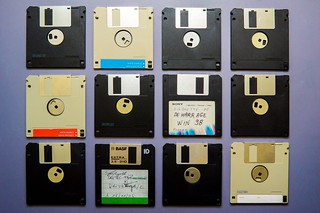
PREV ARTICLE
NEXT ARTICLE
FULL ISSUE
PREV FULL ISSUE
RECOVERING OLD OBSOLETE COMPUTER FILES
Last week we discussed an old humorous essay that made a great point about the utility and staying power of the good old-fashioned book. Books have outlasted every alternative form invented to date, and will likely continue to last for centuries to come. But digital formats and physical storage technology become obsolete quickly and before you know it three generations of technology have come and gone. So how are people dealing with this problem? Here's an article about some important work being done at Yale.
-Editor
One workaround to make these projects possible was to separate a website from the web. “A simple solution was to simply burn all the the HTML, JavaScript, and other large files to a CD-ROM,” Walsh says. These sites spent much of their lives offline—viewable only when a user met the hardware requirements listed by the creator and then inserted the CD. Today, with a decent connection, online video and all sorts of other functionality rarely stumbles. In the march to high-speed wi-fi, browser-based applications, cloud computing, and computers that have no need for CD-ROM drives, some older digital artifacts have been left in the dust. In some cases, it’s as though they’re written in a dead language, so accessing their content can be tricky. The digital world continues to expand and mutate in all sorts of ways that will orphan and otherwise impair file formats and programs—from ones long forgotten to ones that work just fine today but carry no guarantees against obsolescence. Instead of a patchwork of one-off solutions, perhaps there’s a better way to keep old software running smoothly—a simpler process for summoning the past on demand. A team at the Yale University Library is trying to build one. DIGITAL ARCHIVISTS DEAL WITH LEAST two broad categories of artifacts. There are analog objects or documents scanned into a second, digital life—digitized maps, for instance, or scanned photos. The other objects are natives of the digital world. These files can include everything from a simple compressed image to a game on a CD-ROM to a CAD design for a skyscraper. The relentless march of new versions and new platforms makes obsolescence a constant presence, from as soon as digital objects are conceived. RESEARCHERS AT YALE ARE WORKING to solve this problem by creating a kind of digital Rosetta Stone, a universal translator, through an emulation infrastructure that will live online. “A few clicks in your web browser will allow users to open files containing data that would otherwise be lost or corrupted,” said Cochrane, who is now the library’s digital preservation manager. “You’re removing the physical element of it,” says Seth Anderson, the library’s software preservation manager. “It’s a virtual computer running on a server, so it’s not tethered to a desktop.” Instead of treating each case as a one-off, like digital triage, this team wants to create a virtual, historical computer lab that’s comprehensive and ready for anything. Do you have a CD-ROM that was once stuffed in a sleeve on the cover of a textbook? A snappy virtual machine running Windows 98 might be able to help you out. “We could create any environment that we needed,” Anderson says. The goal is to build an emulation library big enough that there’s a good fit for any potential case—with definitive, clear results. Cochrane said the integrity should be strong enough that “you can take an old digital file into court as evidence.”
So don't despair if you've got some good numismatic content stored on old computers, DVDs, CDs, 3.5 or 5 1/4 inch floppy disks. DON'T THROW THEM AWAY. Perhaps someday the content can be easily retrieved and ported over to more modern formats.
-Editor
Len Augsburger of the Newman Numismatic Portal writes: We will fund this work if the content value is there. For example, if someone had a book draft on floppy disk, that would be a no-brainer. As far as I know the record is held by Martin Gengerke who started his work in the 1980s (possibly 1970s) and has managed to keep American Numismatic Auctions digitally accessible.
To read the complete article, see:
To read the earlier E-Sylum article, see:

Wayne Homren, Editor The Numismatic Bibliomania Society is a non-profit organization promoting numismatic literature. See our web site at coinbooks.org. To submit items for publication in The E-Sylum, write to the Editor at this address: whomren@gmail.com To subscribe go to: https://my.binhost.com/lists/listinfo/esylum All Rights Reserved. NBS Home Page Contact the NBS webmaster 
|
